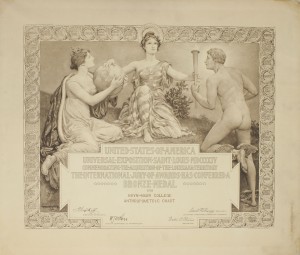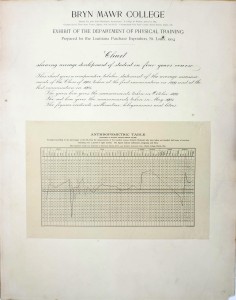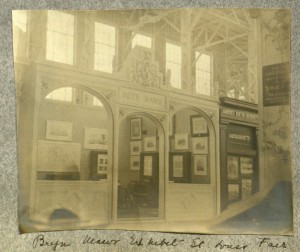Today’s post is by one of our summer interns, Elizabeth Reilly:
Bryn Mawr’s Special Collections has an interesting set of posters and prizes from many world’s fairs, but the bulk of the posters come from the Louisiana Purchase International Exposition of 1904 held in St. Louis. You might recognize this fair’s name from the movie musical, Meet me in St.Louis, starring Judy Garland.This fair commemorated the centennial of the 1803 land purchase, focusing on themes of imperialism and technological advancements. It was also the first fair to have an entire building dedicated to education and social issues, the Palace of Education and Social Economy, which is where Bryn Mawr’s installation was. The fair spanned 1,272 acres and ran from April – December of 1904, attracting approximately 20 million visitors.
In this day and age, fairs and expositions seem obsolete, so what’s the big deal about Bryn Mawr at a fair? Today, thanks to social media, ideas, writings and images can be spread around the world in a matter of seconds. But in the past, World’s Fairs and Expositions served as gathering places for these ideas, inventions and people from all over the globe, so it was important to have an exhibit at one of these international fairs. M. Carey Thomas helped to carefully design Bryn Mawr’s exhibit for the fair to promote the value of women’s education. I use the word ‘carefully’ intentionally, for Bryn Mawr was trying to convey a particular image of what a women’s college was and why women’s education should be supported. In Thomas’ letters, she explains that the St. Louis exhibit was going to be much more elaborate than any of Bryn Mawr’s prior World’s Fairs exhibits. Thomas was also chosen to be a speaker at the fair’s Congress on Education, which she viewed as an “important occasion because not only so many American scholars but a large number of European scholars will be present.” Below is a picture of what Bryn Mawr’s exhibit looked like in the Palace of Education and Social Economy.
The entry way is reflective of the many archways that decorate Bryn Mawr’s campus. Archways are symbols of power and the design of the exhibit help to frame the perception of the space as more important, or impressive, to visitors.
A portion of the posters from 1904 are dedicated to marriage rates of alumnae and from the Department of Physical Training. An award winning chart from the fair is an Anthropometric chart that measures girth, height, depth, breadth, and length of students over the course of their undergraduate career at Bryn Mawr. Weird, right? Can you imagine if this was a part of Customs week: move in to your dorm room, awkwardly talk with your brand new roommates and then head over to the gym to be measured together! I’m pretty sure the student body would riot. But you know what’s even crazier? The fact that the Bryn Mawr administration included posters about female students’ physical well-being in efforts to prove to the world that women were physiologically capable of receiving an equally rigorous education as men and that they, as some believed, would not become infertile and die.
Let me explain more. In 1873, Havard and University of Pennsylvania educated Dr. Edward Hammond Clarke wrote “Sex in Education; or, A Fair Chance for Girls.” In this controversial but widely discussed essay, he promoted the idea that women will become sick, weak, unable to become pregnant and possibly die if they receive a similar education to men. Here’s a sample from his essay: “Those grievous maladies which torture a woman’s earthly existence, called leucorrhoea, amenorrhoea, dysmenorrhoea, chronic and acute ovaritis, prolapsus uteri, hysteria, neuralgia, and the like, are indirectly affected by food, clothing, and exercise; they are directly and largely affected by the causes that will be presently pointed out, and which arise from a neglect of the peculiarities of a woman’s organization. The regimen of our schools fosters this neglect. The regimen of a college arranged for boys, if imposed on girls, would foster it still more.” Click here to read his essay in its entirety. Warning: May cause you to throw blunt objects at your computer screen. Read with caution.
Clarke goes on to refer to puberty as a “critical voyage” for women and he finds it ludicrous that America’s educational structure doesn’t pay attention to the fact that this passage takes place during a large portion of a girl’s educational life. Basically, Clarke thought that the female body was not strong enough or wired correctly to receive an education while also experiencing puberty. This idea was prevalent in the educational world for quite some time. But M. Carey Thomas and other people at Bryn Mawr were trying to turn this notion on its head by providing ample amount of evidence to prove that not only could women thrive at college, but they continued on to graduate school, received fellowships and some even got married, too! The Anthropometric chart won a bronze medal award at the 1904 Exposition, serving as validation that the International Exposition committee was receptive to Bryn Mawr’s assertions that women could succeed in academia without it affecting their physical well-being. According to the charts, many women even improved their physical health while at school. Although, the marriage rate of Bryn Mawr alumnae was down to 18.9% in 1903 from 40% in 1889…Uh-oh, better warn the patriarchy! (hey, hey, ho, ho…)
Over 70 posters about the graduate school program, the Self-Government Association, all of the academic departments and plans for the residence halls were displayed at the St. Louis World’s Fair. Bryn Mawr College received a grand prize for its general exhibit illustrating courses of instruction, and methods and results of college work in various departments as well. Below is part of a letter to M. Carey Thomas from Evelyn Winchester, a student native of St. Louis who had been chosen to oversee the exhibit, informing the President about the award of the Grand Prize. Next to it is an image of the photogravure Grand Prize.

There are also several posters that have students blue book exams mounted on the poster. In true honor code spirit, the names are cut out and yes, these blue books look almost exactly like the ones we still use today. Even through 109 year old posters, I can still feel a connection with Bryn Mawr students of the past who also stressed over their finals and were constantly trying to prove their intelligence and validity of their presence in the academic world.


